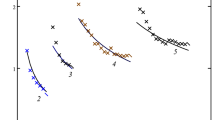Summary
Many-body perturbation theory is derived for chemical bonds. Paired quasiparticles represent the bonds. Products of the paired quasiparticles define a model Bardeen-Cooper-Schrieffer function. The pairing force is added as a model interaction to the self-consistent problem. The starting model is based on valency and adiabatic symmetry correlation. Symmetries are enforced by the model Hamiltonian. Perturbative corrections are expressed as ordinary Feynman diagrams. The number of diagrams needed is the same as for particle-hole theory.
Similar content being viewed by others
References
Pines D (1961) The many-body problem. WA Benjamin, NY
Belyaev ST (1968) Collective excitations in nuclei. Gordon and Breach, NY
Scadron MD (1979) Advanced quantum theory and its applications through Feynman diagrams. Springer-Verlag, NY
Anderson PW (1984) Basic notions of condensed matter physics. Benjamin/Cummings, Menlo Park
Blaizot JP, Ripka G (1986) Quantum theory of finite systems. MIT Press, Cambridge
Ring P, Schuck P (1980) The nuclear many-body problem. Springer-Verlag, Berlin
Nozières P (1964) Theory of interacting Fermi systems. Benjamin, NY
Lindgren I, Morrison J (1986) Atomic many-body theory. Springer-Verlag, Berlin
England WB, Silver DM (1986) J Chem Phys 85:5847
England WB (1982) J Phys Chem 86:1204
England WB (1983) Int J Quantum Chem 23:905
England WB (1983) Int J Quantum Chem Symp 17:357
Sorensen TE, England WB, Silver DM (1986) Int J Quantum Chem Symp 20:81
Lipkin HJ (1960) Ann Phys (NY) 9:272
England WB, Silver DM, Steinborn EO (1984) J Chem Phys 81:4546
Sorensen TE, England WB, Silver DM (1989) J Phys B 22:L539
Nogami Y (1964) Phys Rev 134:B313
Sorensen TE (1989) Bardeen-Cooper-Schrieffer-Lipkin-Nogami theory: A new method for electronic structure calculations with applications to potential energy curves for H2, LiH, FH, F2, and N2. PhD thesis, Univ of Wisconsin-Milwaukee
Rowe DJ (1970) Nuclear collective motion: Models and theory. Methuen, London
Sorensen TE, England WB, Silver DM (1992) Quantum field theoretical methods in chemically bonded systems III. BCSLN-HL(N) potential energy curves for the ground states of H2, LiH, FH and F2. Theor Chim Acta 84:21–35
March NH, Young WH, Sampanthar S (1967) The many-body problem in quantum mechanics. Cambridge Univ Press, London.
Schrieffer JR (1964) Theory of superconductivity. WA Benjamin, NY
Brandow BH (1967) Rev Mod Phys 39:771
Mattuck RD (1976) A guide to Feynman diagrams in the many-body problem. McGraw-Hill, NY
Hunt WJ, Hay PJ, Goddard WA (1972) J Chem Phys 57:738
Silver DM (1978) Comput Phys Commun 14:71
Silver DM (1978) Comput Phys Commun 14:81
Wilson S (1978) Comput Phys Commun 14:91
Author information
Authors and Affiliations
Additional information
This work was supported in part by the U.S. Department of the Navy, Space and Naval Warfare Systems Command under Contract N00039-89-C-0001, and in part by NATO Research Grant 1861. It was presented, in part, at the A.C. Wahl Memorial Session, Molecular Spectroscopy Symposium, Columbus, Ohio, 1984; and Midwest Theoretical Chemistry Conference, Milwaukee, Wisconsin, 1985.
Rights and permissions
About this article
Cite this article
Sorensen, T.E., England, W.B., Silver, D.M. et al. Quantum field theoretical methods in chemically bonded systems II. Theoret. Chim. Acta 84, 1–19 (1992). https://doi.org/10.1007/BF01117400
Received:
Accepted:
Issue Date:
DOI: https://doi.org/10.1007/BF01117400




